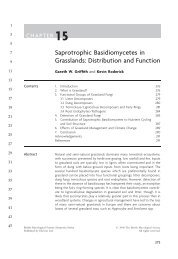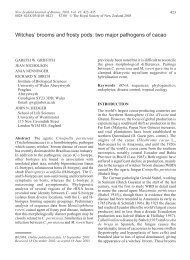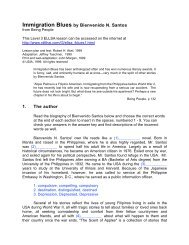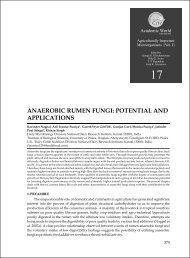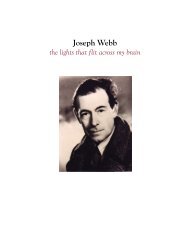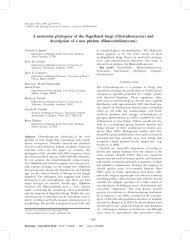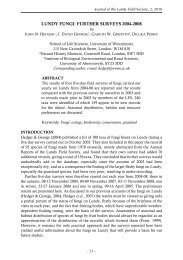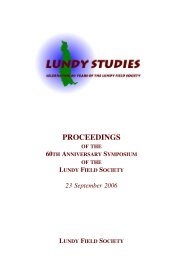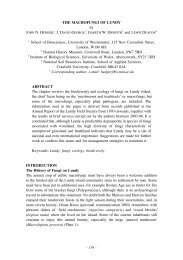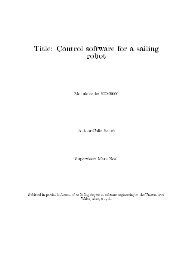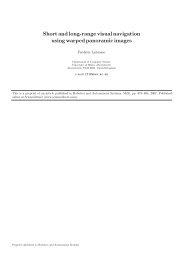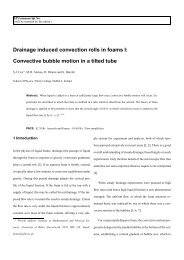Acremonium crotocinigenum - Aberystwyth
Acremonium crotocinigenum - Aberystwyth
Acremonium crotocinigenum - Aberystwyth
Create successful ePaper yourself
Turn your PDF publications into a flip-book with our unique Google optimized e-Paper software.
An antibacterial hydroxy fusidic acid analogue from<br />
<strong>Acremonium</strong> <strong>crotocinigenum</strong><br />
Liam Evans a , John N. Hedger b , David Brayford b , Michael Stavri c , Eileen Smith c ,<br />
Gemma O’Donnell c , Alexander I. Gray d , Gareth W. Griffith e , Simon Gibbons c, *<br />
a Hypha Discovery Ltd., School of Biosciences, University of Westminster, 115 New Cavendish Street, London W1W 6UW, UK<br />
b School of Biosciences, University of Westminster, 115 New Cavendish Street, London W1W 6UW, UK<br />
c Centre for Pharmacognosy and Phytotherapy, The School of Pharmacy, University of London, 29-39 Brunswick Square, London WC1N 1AX, UK<br />
d Department of Pharmaceutical Sciences, University of Strathclyde, 27 Taylor Street, Glasgow G4 0NR, UK<br />
e Institute of Biological Sciences, University of Wales, <strong>Aberystwyth</strong>, Penglais, <strong>Aberystwyth</strong> SY23 3DD, UK<br />
Abstract<br />
Received 3 May 2006; received in revised form 19 June 2006<br />
Available online 22 August 2006<br />
A fusidane triterpene, 16-deacetoxy-7-b-hydroxy-fusidic acid (1), was isolated from a fermentation of the mitosporic fungus <strong>Acremonium</strong><br />
<strong>crotocinigenum</strong>. Full unambiguous assignment of all 1 H and 13 C data of 1 was carried out by extensive one- and two-dimensional<br />
NMR studies employing HMQC and HMBC spectra.<br />
Compound 1 was tested against a panel of multidrug-resistant (MDR) and methicillin-resistant Staphylococcus aureus (MRSA)<br />
strains and showed minimum inhibitory concentration values of 16 lg/ml.<br />
Ó 2006 Elsevier Ltd. All rights reserved.<br />
Keywords: <strong>Acremonium</strong> <strong>crotocinigenum</strong>; Fusidane triterpene; Fusidic acid; Antibacterial; MRSA; MDR; Staphylococcus aureus<br />
1. Introduction<br />
Phytochemistry 67 (2006) 2110–2114<br />
Our studies on the production of metabolites by taxa of<br />
tropical rainforest fungi in fermentation, have led to the<br />
isolation and characterisation of a new metabolite, designated<br />
16-deacetoxy-7b-hydroxy-fusidic acid (1), which is<br />
structurally related to the commercial antibiotic, fusidic<br />
acid, a widely used therapeutic for methicillin-resistant<br />
Staphylococcus aureus (MRSA) infections which is still of<br />
interest as a template for antibiotic activity improvement<br />
(Søtofte and Duvold, 2001). The metabolite is a prominent<br />
component of fermentation liquors from shake cultures of<br />
an isolate of the mitosporic fungus <strong>Acremonium</strong> <strong>crotocinigenum</strong>,<br />
cultured from rotting wood in Rio Palenque Forest<br />
* Corresponding author. Tel.: +44 207 7535913; fax: +44 207 7535909.<br />
E-mail address: simon.gibbons@pharmacy.ac.uk (S. Gibbons).<br />
0031-9422/$ - see front matter Ó 2006 Elsevier Ltd. All rights reserved.<br />
doi:10.1016/j.phytochem.2006.06.033<br />
PHYTOCHEMISTRY<br />
www.elsevier.com/locate/phytochem<br />
Reserve, Pichincha Province, Ecuador in 1986, and currently<br />
held in the University of Westminster culture collection.<br />
<strong>Acremonium</strong> is a polyphyletic genus, often confused<br />
with Cephalosporium and is related to a number of ascomycete<br />
teleomorphs (Gams, 1971). It contains some 105 species,<br />
including a number which have been shown to<br />
produce biologically active metabolites (Kirk et al.,<br />
2001). Previous studies on A. <strong>crotocinigenum</strong> found sesquiterpenoid<br />
compounds of the isocrotonic acid type (Gyimesi<br />
and Melera, 1967).<br />
The detection of 1 was part of a programme for screening<br />
tropical fungi for new antibiotics with activity against<br />
MRSA. There is currently an acute need for new effective<br />
antibiotics for MRSA treatment, especially since the<br />
appearance of vancomycin resistant (VRSA) strains (Centers<br />
for Disease Control and Prevention, 2003; Chang<br />
et al., 2003). Liquid fermentation was used in conjunction
with bioautography, to qualitatively indicate the presence<br />
of antibacterial compounds, facilitating the isolation of<br />
compound 1 by vacuum liquid chromatography.<br />
2<br />
3<br />
HO<br />
2. Results and discussion<br />
26<br />
23 24<br />
25<br />
27<br />
HO 11<br />
CO2H H<br />
1 9<br />
10<br />
5 H<br />
8<br />
4<br />
H<br />
6<br />
7 OH<br />
(1)<br />
12<br />
20<br />
17<br />
19 13<br />
14<br />
16<br />
18<br />
15<br />
21<br />
22<br />
30<br />
28<br />
Bioautography of the Diaion HP20 resin extract of the<br />
fermentation filtrate led to the isolation of compound 1<br />
as a white solid. High-resolution ESI-TOFMS in the positive<br />
mode suggested a molecular formula of C29H46O5. Signals<br />
in the 1 Hand 13 C NMR spectra (Table 1) for five<br />
Table 1<br />
1 13 1 13<br />
H (400 MHz) and C NMR (100 MHz) spectral data and H– C longrange<br />
correlations of 1 recorded in CDCl3 1 H<br />
13 C<br />
Position<br />
1 1.50 m, 2.23 m 30.0<br />
2 1.75 m, 1.81 m 29.9<br />
3 3.73 bq 71.4 C-2 C-5<br />
4 1.54 m 37.3<br />
5 2.31 m 36.2<br />
6 1.45 m, 1.67 m 34.1<br />
7 3.99 t (8.0) 70.9 C-6 C-14, C-30<br />
8 – 45.6 – –<br />
9 1.52 m 50.8 – –<br />
10 – 36.7 – –<br />
11 4.37 bs 68.7 – C-8<br />
12 1.75 m, 2.39 m 36.4<br />
13 3.05 bd (12.1) 46.0 C-14, C-17 C-15, C-20<br />
14 – 49.6 – –<br />
15 1.54 m, 1.77 m 33.4 – –<br />
16 2.68 m, 2.86m 33.0 C-15, C-17 C-20<br />
17 – 160.4 – –<br />
18 0.89 s 15.9 C-14 C-8, C-13, C-15<br />
19 0.95 s 24.4 C-10 C-5, C-1, C-9<br />
20 – 125.0 – –<br />
21 – 173.8 – –<br />
22 2.44 m 28.5 C-20, C-23 C-17, C-21<br />
23 2.02 m, 2.17 m 29.4 C-22, C-24 C-25<br />
24 5.12 t, (7.2) 124.0 C-23 C-26, C-27<br />
25 – 132.2 – –<br />
26 1.61 s 18.0 C-25 C-24, C-27<br />
27 1.67 s 25.9 C-25 C-24, C-26<br />
28 0.93 d (6.8) 16.0 C-4 C-3, C-5<br />
30 1.36 s 14.6 C-8 C-7, C-9, C-14<br />
2 J<br />
L. Evans et al. / Phytochemistry 67 (2006) 2110–2114 2111<br />
3 J<br />
methyl singlets, one methyl doublet, four olefinic carbons<br />
and a carbonyl of a carboxylic acid (dC 173.8), were indicative<br />
of a fusidane class triterpene of the fusidic acid type<br />
(Rastup-Andersen and Duvold, 2002).<br />
By careful analysis of the HMBC, HMQC and COSY<br />
spectra it was possible to show that 1 was a new fusidic acid<br />
analogue. Assuming that the methyl doublet was C-28 of<br />
the fusidane skeleton, the protons of this group coupled<br />
to a methine proton (d H 1.54, H-4) in the COSY spectrum.<br />
H-4 formed part of a spin system with a deshielded methine<br />
(dH 3.73, H-3) and two methylene groups (at C-2 and C-1).<br />
In the HMBC spectrum, C-1 was coupled to by the protons<br />
of methyl-C19 (dH 0.95) which showed further couplings to<br />
C-10 ( 2 J), C-9 ( 3 J) and C-5 ( 3 J). In the COSY spectrum, H-<br />
5(d H 2.31 m) coupled to both protons of a methylene moiety<br />
(C-6, d H 1.45, 1.67), which further coupled to a<br />
deshielded oxymethine proton (C-7, d H 3.00, t). Inspection<br />
of the HMBC spectrum showed that the carbon associated<br />
with this deshielded proton was coupled to by the protons<br />
of a further angular methyl singlet (C-30), which showed<br />
additional couplings to a methine carbon (C-9) and two<br />
quaternary carbons (C-8, dC 45.6 and C-14, dC 49.6). This<br />
completed the resonances for the A and B rings of compound<br />
1. Inspection of the COSY spectrum showed that<br />
the proton associated with C-9 (H-9) formed part of a<br />
CH–CH–CH2–CH spin system which allowed identification<br />
of positions C-9, C-11, C-12 and C-13, respectively.<br />
C-11 was deshielded (dC 68.7, dH 4.37) indicating that an<br />
oxygen should be placed here. Furthermore, H-13 (delineated<br />
by inspection of the HMQC spectrum) was also<br />
deshielded (d H 3.05) suggesting that it was allylic and that<br />
an olefinic carbon (C-17) should be placed at the neighbouring<br />
carbon, which is typical for fusidic acid metabolites<br />
(Rastup-Andersen and Duvold, 2002). The protons<br />
of a methyl group (C-18) coupled to C-13 ( 3 J), C-14 ( 2 J)<br />
and to a methylene carbon (C-15, 3 J). CH2-15 coupled to<br />
a deshielded allylic methylene group (dH 2.68, 2.86 (CH2-<br />
16)) which again was supportive of being alpha to an olefinic<br />
carbon (C-17, d C 160.4). This completed rings C and<br />
Dof1. H-13 and H 2-16 both gave a 2 J coupling to C-17<br />
and a 3 J coupling to C-20, suggesting a C-17,20 double<br />
bond. In the HMBC spectrum C-17 was also coupled to<br />
by the protons of an allylic methylene (C-22, dH 2.44)<br />
which also coupled to a carbonyl carbon of a carboxylic<br />
acid group (C-21) and an olefinic methine carbon (C-24,<br />
dC 124.0). A further methylene (C-23) could be placed<br />
between C-22 and C-24 by couplings observed in the<br />
COSY spectrum. Finally, two deshielded geminal methyl<br />
groups could be placed on an olefinic carbon (C-25) via<br />
their HMBC correlations to this carbon and to the olefinic<br />
partner C-24 finalising the C-24–C-25 double bond. These<br />
resonances completed the eight carbon chain of the fusidane<br />
triterpene skeleton. HRESI-MS of 1 suggested a<br />
molecular formula of C29H46O5 [M] + (475.3422). From<br />
the chemical shift values of H-3, H-7 and H-11, hydroxyl<br />
groups must be placed at these positions. From the molecular<br />
formula and chemical shift of the C-21 carbon, a car-
2112 L. Evans et al. / Phytochemistry 67 (2006) 2110–2114<br />
boxylic acid must be placed at C-21 and this is identical to<br />
that seen in fusidic acid (see Fig. 1).<br />
The final consideration was to assign stereochemistry of<br />
hydroxyl groups at C-3, C-7 and C-11. The hydrogens at<br />
C-3 and C-11 were assigned as equatorial (rel b) on the<br />
basis of no large discernable couplings for these signals,<br />
which would make the hydroxyl groups at these positions<br />
both a and axial. The coupling constant for H-7 (d 3.99,<br />
t) was 8.0 Hz indicating an axial-axial interaction with<br />
the axial partner of CH2-6. This would make H-7 axial<br />
(a) and the OH at this position therefore equatorial (b).<br />
This was further supported by an NOE between H-7 and<br />
CH3-30 indicating that they are both on the alpha face of<br />
the fusidane skeleton.<br />
Fusidic acid and all known analogues to date have no<br />
substitution on carbon 7. Compound 1 possesses an hydroxyl<br />
at this position. A. <strong>crotocinigenum</strong> has also been found<br />
to produce analogues with an hydroxyl on carbon 16 and 1<br />
is the first member of this class to be completely unsubstituted<br />
at the C-16 position.<br />
Compound 1 was tested against a battery of drug-resistant<br />
bacteria and where active, possessed a minimum inhibitory<br />
concentration of 16 lg/ml, which although<br />
occasionally more active than erythromycin and norfloxacin,<br />
was significantly less potent than the fusidic acid<br />
comparator.<br />
3. Experimental<br />
HO<br />
HO<br />
3.1. General experimental procedures<br />
H<br />
H H<br />
HH<br />
H<br />
CO 2H<br />
Fig. 1. Key COSY (double headed arrow) and HMBC (single headed<br />
arrow) correlations for compound 1.<br />
NMR spectra were recorded on a Bruker AVANCE<br />
500 MHz spectrometer. Chemical shift values (d) were<br />
reported in parts per million (ppm) relative to appropriate<br />
internal solvent standard and coupling constants (J values)<br />
are given in Hertz. Accurate mass measurements were<br />
determined on a Micromass Q-TOF Ultima Global Tandem<br />
Mass Spectrometer. The sample was run under electrospray<br />
ionisation mode using 50% acetonitrile in water<br />
and 0.1% formic acid as solvent. [Glu]-fibrinopeptide B<br />
(1)<br />
OH<br />
peptide was used as an internal standard,<br />
[M+2H] 2+ = 785.8426.<br />
IR spectra were recorded on a Nicolet 360 FT-IR spectrophotometer<br />
and UV spectra on a Thermo Electron Corporation<br />
Helios spectrophotometer.<br />
3.2. Fungal strain<br />
Cultures were maintained on malt extract agar (Oxoid)<br />
and for long term storage on malt extract agar plugs submerged<br />
in sterile distilled water at room temperature, as<br />
part of the University of Westminster culture collection<br />
(Culture No. cc56). The isolate was identified as A. <strong>crotocinigenum</strong><br />
by David Brayford, initially through DNA<br />
sequencing of a PCR product amplified from the variable<br />
ITS (internal transcribed spacer) region of the ribosomal<br />
RNA locus using the conserved primers ITS1F and ITS4<br />
(White et al., 1990; Gardes and Bruns, 1993). A search of<br />
DNA sequence databases with 508 bp of DNA sequence<br />
from this PCR product using the FASTA algorithm (Pearson<br />
and Lipman, 1988; http://www.ebi.ac.uk/fasta/)<br />
revealed the most closely related sequence accession to be<br />
AJ621773 (<strong>Acremonium</strong> <strong>crotocinigenum</strong>), which showed<br />
98.2% identity over a 513 bp overlap. This A. <strong>crotocinigenum</strong><br />
strain was isolated from the basidiome of Trametes<br />
versicolor in a Hungarian coal mine (Schol-Schwarz,<br />
1965) and was named by Gams (1971). Comparisons of<br />
the conidia, chlamydospores and colony appearance with<br />
those described in Schol-Schwarz (1965) and Gams<br />
(1971) were used to confirm that cc56 was indeed morphologically<br />
the same as A. <strong>crotocinigenum</strong>. Further confirmation<br />
was obtained by direct comparison of cc56 with strain<br />
CABI 112775 (syn. CBS 129.64) kindly supplied by the<br />
International Mycological Institute, Egham, UK. The<br />
ITS sequence for isolate cc56 has been deposited in the<br />
GenBank database (accession number DQ882846).<br />
3.3. Fermentation and extraction<br />
Inoculum for the fermentation was prepared by vigorously<br />
shaking twenty 8 mm diameter plugs, excised from<br />
an actively growing culture of A. <strong>crotocinigenum</strong> on 2%<br />
malt extract agar (Oxoid), in 10 ml of sterile distilled water<br />
containing 2–3 ml of glass beads (VWR). The resulting<br />
mycelial suspension (2 ml) was added to each of twenty<br />
1000 ml conical flasks, containing 200 ml of sterilised 2%<br />
potato dextrose broth (Difco). The flasks were incubated<br />
on a rotary shaker (200 rpm) for two weeks at 26 °C.<br />
Biomass was removed from the culture broth by filtering<br />
through muslin prior to filtration through a Whatman No.<br />
1 filter paper. The filtrate was then extracted with Diaion<br />
HP20 resin (400 ml; Mitsubishi) which had previously been<br />
washed with HPLC grade methanol (Merck) and thoroughly<br />
conditioned with distilled water. The resin was<br />
removed, washed with distilled water (2 · 1000 ml) and<br />
eluted with HPLC grade methanol (2 · 1000 ml). The<br />
methanolic eluent was evaporated to dryness.
3.4. Isolation<br />
The crude HP20 resin extract of the culture filtrate was<br />
dissolved in methanol (5 ml) and combined with an equivalent<br />
mass of silica gel (flash chromatography grade; BDH;<br />
1.6 g) and evaporated. The slurry was packed in a pre-column<br />
cartridge assembled in a Biotageä chromatography<br />
apparatus along with a 40 mm diameter silica gel column.<br />
The column was eluted with the following mobile phase<br />
fractions: 100% dichloromethane (100 ml), 2% methanol/<br />
dichloromethane (200 ml), 4% methanol/dichloromethane<br />
(200 ml), 6% methanol/dichloromethane (200 ml), 8%<br />
methanol/dichloromethane (200 ml) and finally 10% methanol/dichloromethane<br />
(200 ml). None of the fractions were<br />
observed to contain the desired metabolite which had correlated<br />
to a zone of inhibition in the bioautographical analysis.<br />
The column was therefore further eluted with 20%<br />
methanol/dichloromethane and a series of 30 ml volume<br />
fractions were collected. TLC analysis showed the target<br />
compound to be present in fractions 7–18. These fractions<br />
were combined, evaporated to dryness and re-dissolved in<br />
9:1 ethyl acetate/n-hexane (2 ml) for further fractionation<br />
on a 10 mm diameter Biotage column, using isocratic 9:1<br />
ethyl acetate/n-hexane as the mobile phase, fractionated<br />
into 7 ml fractions. The target compound was contained<br />
in fractions 5–15, these were combined, dried and reconstituted<br />
in 8% methanol/dichloromethane for further isocratic<br />
fractionation using the same solvent and a 10 mm<br />
Biotage column. Fractions of 3 ml volume were collected,<br />
TLC analysis showed the compound to be solely present<br />
in fractions 12–32. These fractions were combined and<br />
the dry weight of pure compound determined to be<br />
17.1 mg.<br />
3.5. Thin layer chromatography and bioautography analysis<br />
Thin layer chromatography (TLC) separation was<br />
achieved using silica gel plates and three solvent systems<br />
(9:1 dichloromethane/methanol; 6:4 ethyl acetate/n-hexane<br />
and 9:1 ethyl acetate/n-hexane). All solvents used were<br />
HPLC grade.<br />
Metabolites were visualised on the TLC plates by spraying<br />
with a 4% vanillin/concentrated sulphuric acid solution<br />
and heating with a hot air gun.<br />
L. Evans et al. / Phytochemistry 67 (2006) 2110–2114 2113<br />
Bioautographic analysis was performed using Staphylococcus<br />
aureus (NCTC 6571) as the test organism.<br />
S. aureus inoculum was prepared by seeding a 100 ml<br />
conical flask containing sterile nutrient broth (10 ml), the<br />
flask was shaken overnight at 200 rpm at 37 °C.<br />
The inoculum was applied to the run TLC plates by<br />
gently dabbing with sterilised foam. The seeded plates were<br />
subsequently incubated overnight at 37 °C in a humidified<br />
chamber. The incubated plates were then sprayed with<br />
nitro-blue tetrazolium (Sigma Ltd.) in order to stain the<br />
live S. aureus and then re-incubated for 1 h to develop,<br />
the undeveloped areas of the plates indicating the presence<br />
of growth-inhibiting compounds.<br />
3.6. Antibacterial assay<br />
S. aureus strain ATCC 25923 was the generous gift of E.<br />
Udo (Kuwait University, Kuwait). S. aureus RN4220 containing<br />
plasmid pUL5054, which carries the gene encoding<br />
the MsrA macrolide efflux protein, was provided by J.<br />
Cove (Ross et al., 1989). Strain XU-212, which possesses<br />
the TetK tetracycline efflux protein, was provided by E.<br />
Udo (Gibbons and Udo, 2000). SA-1199B, which<br />
overexpresses the norA gene encoding the NorA MDR<br />
efflux protein was provided by G. Kaatz (Kaatz et al.,<br />
1993). All Staphylococcus aureus strains were cultured on<br />
nutrient agar and incubated for 24 h at 37 °C prior to<br />
MIC determination. Bacterial inocula equivalent to the<br />
0.5 McFarland turbidity standard were prepared in normal<br />
saline and diluted to give a final inoculum density of<br />
5 · 10 5 cfu/ml. The inoculum (125 ll) was added to all<br />
wells and the microtitre plate was incubated at 37 °C for<br />
18 h. The MIC was recorded as the lowest concentration<br />
at which no bacterial growth was observed as previously<br />
described (Gibbons and Udo, 2000) (see Table 2).<br />
3.7. 16-Deacetoxy-7b-hydroxyfusidic acid (1)<br />
White powder; ½aŠ 21<br />
D 113:64 (c 0.08, CHCl 3); UV<br />
(ACN) k max (log e): 233 (3.96) nm; IR m max (thin film)<br />
cm 1 : 3369.62, 2924.39, 1715.97, 1696.02, 1558.27,<br />
1436.56, 1375.42, 1255.07 1053.01, 934.01, 653.86; 1 H<br />
NMR and 13 C NMR (CDCl3): see Table 1; HRES-MS<br />
(m/z): 475.3422 [M+H] + (calc. for C29H47O5, 475.3418).<br />
Table 2<br />
MICs of 1 and standard antibiotics in lg/ml<br />
Strain (resistance mechanism) 1 Fusidic acid Norfloxacin Erythromycin Tetracycline<br />
ATCC 25923 16 0.125 2 0.25 0.25<br />
SA-1199B (NorA) 16 0.125 32 0.25 0.25<br />
RN4220 (MsrA) 16 0.25 2 128 0.25<br />
XU212 (TetK, mecA) >64 >64 16 >256 128<br />
EMRSA-15 16 0.125 0.5 2048 0.125<br />
EMRSA-16 (mecA)<br />
All MICs were determined in duplicate.<br />
>64 4 128 4096 0.125
2114 L. Evans et al. / Phytochemistry 67 (2006) 2110–2114<br />
Acknowledgements<br />
We acknowledge the contribution of the late David<br />
Brayford, who sadly passed away before the publication<br />
of this paper. We thank the Engineering and Physical Sciences<br />
Research Council (Grant No. GR/R47646/01). We<br />
also thank Ing. Raul Camacho and staff of the Facultad<br />
de Ciencias, Escuela Superior Politecnica de Chimborazo,<br />
Riobamba, Ecuador for assistance with field work in Ecuador,<br />
and Cal & Piedad Dodson for permission to collect in<br />
Rio Palenque Reserve.<br />
References<br />
Centers for Disease Control (CDC), 2002. Public health dispatch:<br />
vancomycin-resistant Staphylococcus aureus – Pennsylvania. Morbid.<br />
Mortal. Week. Rep. 51, 902.<br />
Chang, S., Sievert, D.M., Hageman, J.C., Boulton, M.L., Tenover, F.C.,<br />
Downes, F.P., Shah, S., Rudrik, J.T., Pupp, G.R., Brown, W.J.,<br />
Cardo, D., Fridkin, S.K.and the Vancomycin-Resistant Staphylococcus<br />
aureus Investigative Team, 2003. Infection with vancomycinresistant<br />
Staphylococcus aureus containing the vanA resistance gene.<br />
New Eng. J. Med. 348, 1342–1347.<br />
Gams, W., 1971. Cephalosporium-artige Schimmelpilze (Hyphomycetes).<br />
Gustav Fischer Verlag, Jena, 262 pp.<br />
Gardes, M., Bruns, T.D., 1993. ITS primers with enhanced specificity for<br />
basidiomycetes – application to the identification of mycorrhizae and<br />
rusts. Mol. Ecol. 2, 113–118.<br />
Gibbons, S., Udo, E.E., 2000. The effect of reserpine, a modulator of<br />
multidrug efflux pumps, on the in vitro activity of tetracycline<br />
against clinical isolates of methicillin resistant Staphylococcus aureus<br />
(MRSA) possessing the Tet(K) determinant. Phytother. Res. 14,<br />
139–140.<br />
Gyimesi, J., Melera, A., 1967. Structure of crotocin, an antifungal<br />
antibiotic. Tetahedron Lett. 17, 1665–1673.<br />
Kaatz, G.W., Seo, S.M., Ruble, C.A., 1993. Efflux-mediated fluoroquinolone<br />
resistance in Staphylococcus aureus. Antimicrob. Agents<br />
Chemother. 37, 1086–1094.<br />
Kirk, P.M., Cannon, P.F., David, J.C., Stalpers, J.A., 2001. Ainsworth<br />
and Bisby’s Dictionary of the Fungi, ninth ed. CAB International,<br />
Wallingford, UK, 624 pp.<br />
Pearson, W.R., Lipman, D.J., 1988. Improved tools for biological<br />
sequence comparison. PNAS 85, 2444–2448.<br />
Rastup-Andersen, N., Duvold, T., 2002. Reassignment of the 1 HNMR<br />
spectrum of fusidic acid and total assignment of 1 H and 13 CNMR<br />
spectra of some selected fusidane derivatives. Mag. Res. Chem. 40,<br />
471–473.<br />
Ross, J.I., Farrell, A.M., Eady, E.A., Cove, J.H., Cunliffe, W.J., 1989.<br />
Characterisation and molecular cloning of the novel macrolidestreptogramin<br />
B resistance determinant from Staphylococcus epidermidis.<br />
J. Antimicrob. Chemother. 24, 851–862.<br />
Schol-Schwarz, M.B., 1965. Cephalosporium <strong>crotocinigenum</strong> sp. nov.<br />
Trans. Brit. Mycol. Soc. 48, 51–53.<br />
Søtofte, I., Duvold, T., 2001. A new potent fusidic acid analogue. Acta<br />
Crystallogr. E57, o829–o831.<br />
White, T.J., Bruns, T., Lee, S., Taylor, J.W., 1990. Amplification and<br />
direct sequencing of fungal ribosomal RNA genes for phylogenetics.<br />
In: Innis, M.A., Gelfand, D.H., Sninsky, J.J., White, T.J. (Eds.), PCR<br />
Protocols: A Guide to Methods and Applications. Academic Press,<br />
Inc., New York, pp. 315–322.



